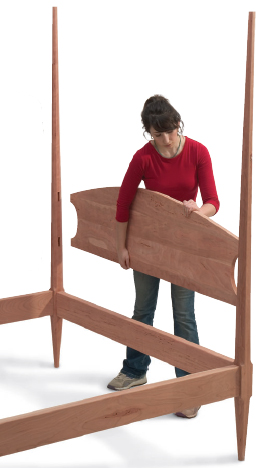
I am a novice woodworker and am in a quandary. I am building a four-poster bed out of soft maple and have a problem with the multitude of dyes that are sold by various retailers. Question: I would like to have the soft maple stained to look like cherry – or reasonably so. Can you suggest what water/solvent/alcohol dye that could be used to achieve this color? Any info would be much appreciated. — Bill Kirk
Tim Inman: It isn’t the brand that makes the difference. Yes, different artisans prefer different brands, but that is only a fraction of the overall end product. There are so many variables, including your eyes and your “mind’s eye” vision for what you want to achieve. The only good way to know what you will get with whatever product(s) you chose to use is to TEST, TEST, TEST. Make up some sample boards using the same soft maple wood from which you are making your bed. Scraps? No, SAMPLES. An oldie but goodie reference source would be George Frank’s books. He was the master at using chemicals and dyes to color wood fibers. You have to wade through his stories to get to the meat of his teachings, but he knew what he was talking about (and the stories are fun, too). I serve on the advisory committee for the Dakota Technical College Wood Finishing Program. That’s where I met George Frank many years ago. He adopted the program as his own, and he spent many hours there working with the students. He was the genuine article — and truly the character he portrayed himself to be in his books.
Generally, water-based dyes are more lightfast and deeper penetrating than the others — generally. Alcohol and NGR (Non Grain Raising) dyes are easier to use because they don’t raise the wood grain when applied. Although I feel this is a very much overrated problem, it is a fact. I prefer water-based products whenever I have an option. Some of the newer metalized dyes can be equally lightfast, whether mixed in an alcohol or water solution. Of course, always follow the manufacturer’s instructions on the label!
For the very best looks, I find that a light tint with dye products (a little dye and a lot of liquid) followed by conventional oil-based wiping stains yields the goods. Seal lightly between each step with a ‘wash’ of sealer or shellac. (My washes are usually something like 10 percent sealer/shellac and 90 percent appropriate solvent.) Dry, then scuff-sand lightly with a sanding sponge before continuing with each next step. Keep records of what you’ve done!
One last note: Soft maple tends to be “blotchy” when stained or tinted conventionally. It is a spongy wood. To equalize the light/dark areas, sometimes it is a good idea to apply a light wash of shellac or sealer to the sanded bare wood before applying any staining materials. Scuff sand for smoothness and go for it. Again, test before you try it on your final project.
Your seemingly easy question turns the key to unlock a lifetime’s experience and work. Perfect is the enemy of good, remember. Practice, practice, practice. I cover many staining and coloring techniques — and answer questions like yours — in my book, The Art of Classical Furniture Finishing. It is available through Amazon or from www.historicinteriors.com in both paper and ebook formats.





